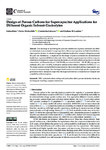Design of Porous Carbons for Supercapacitor Applications for Different Organic Solvent-Electrolytes
| dc.contributor.author | Bates, J | |
| dc.contributor.author | Markoulidis, F | |
| dc.contributor.author | Lekakou, C | |
| dc.contributor.author | Laudone, GM | |
| dc.date.accessioned | 2021-03-19T10:30:00Z | |
| dc.date.available | 2021-03-19T10:30:00Z | |
| dc.date.issued | 2021-01-29 | |
| dc.identifier.issn | 2311-5629 | |
| dc.identifier.issn | 2311-5629 | |
| dc.identifier.other | ARTN 15 | |
| dc.identifier.uri | http://hdl.handle.net/10026.1/16964 | |
| dc.description.abstract |
<jats:p>The challenge of optimizing the pore size distribution of porous electrodes for different electrolytes is encountered in supercapacitors, lithium-ion capacitors and hybridized battery-supercapacitor devices. A volume-averaged continuum model of ion transport, taking into account the pore size distribution, is employed for the design of porous electrodes for electrochemical double-layer capacitors (EDLCs) in this study. After validation against experimental data, computer simulations investigate two types of porous electrodes, an activated carbon coating and an activated carbon fabric, and three electrolytes: 1.5 M TEABF4 in acetonitrile (AN), 1.5 M TEABF4 in propylene carbonate (PC), and 1 M LiPF6 in ethylene carbonate:ethyl methyl carbonate (EC:EMC) 1:1 v/v. The design exercise concluded that it is important that the porous electrode has a large specific area in terms of micropores larger than the largest desolvated ion, to achieve high specific capacity, and a good proportion of mesopores larger than the largest solvated ion to ensure fast ion transport and accessibility of the micropores.</jats:p> | |
| dc.format.extent | 15-15 | |
| dc.language | en | |
| dc.language.iso | en | |
| dc.publisher | MDPI AG | |
| dc.subject | EDLC | |
| dc.subject | activated carbon coating | |
| dc.subject | activated carbon fabric | |
| dc.subject | porous electrodes | |
| dc.subject | electrolyte | |
| dc.subject | ion transport | |
| dc.subject | modeling | |
| dc.subject | computer simulations | |
| dc.title | Design of Porous Carbons for Supercapacitor Applications for Different Organic Solvent-Electrolytes | |
| dc.type | journal-article | |
| dc.type | Article | |
| plymouth.issue | 1 | |
| plymouth.volume | 7 | |
| plymouth.publication-status | Published online | |
| plymouth.journal | C | |
| dc.identifier.doi | 10.3390/c7010015 | |
| plymouth.organisational-group | /Plymouth | |
| plymouth.organisational-group | /Plymouth/Faculty of Science and Engineering | |
| plymouth.organisational-group | /Plymouth/Faculty of Science and Engineering/School of Geography, Earth and Environmental Sciences | |
| plymouth.organisational-group | /Plymouth/REF 2021 Researchers by UoA | |
| plymouth.organisational-group | /Plymouth/REF 2021 Researchers by UoA/UoA07 Earth Systems and Environmental Sciences | |
| plymouth.organisational-group | /Plymouth/Users by role | |
| plymouth.organisational-group | /Plymouth/Users by role/Academics | |
| dcterms.dateAccepted | 2021-01-26 | |
| dc.rights.embargodate | 2021-3-20 | |
| dc.identifier.eissn | 2311-5629 | |
| dc.rights.embargoperiod | Not known | |
| rioxxterms.versionofrecord | 10.3390/c7010015 | |
| rioxxterms.licenseref.uri | http://www.rioxx.net/licenses/all-rights-reserved | |
| rioxxterms.licenseref.startdate | 2021-01-29 | |
| rioxxterms.type | Journal Article/Review |


